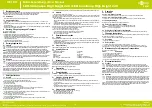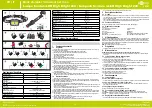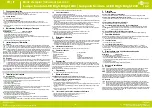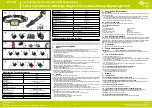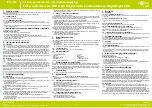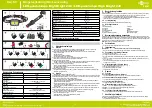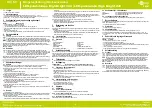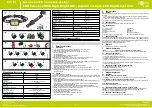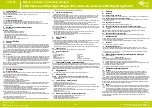
Goobay®
by Wentronic GmbH | Pillmannstraße 12
38112 Braunschweig | Germany
REV2022-09-20
V1.1ir
58391
LED-Stirnlampe High Bright 240 | LED headlamp High Bright 240
7 Batterien wechseln
Wenn die Leuchtkraft der Stirnlampe und/oder des Sicherheitsrücklichtes insgesamt schwächer wird oder
diese sich nicht mehr anschalten lassen, müssen die Batterien gewechselt werden.
•
Beachten Sie hierzu den Sicherheitshinweis unter Kapitel 5 „Inbetriebnahme“.
7.1 Stirnlampe
•
Gehen Sie hierzu wie unter Kapitel 5.1 beschrieben vor.
7.2
Sicherheitsrücklicht
1.
Zum Entnehmen der verbrauchten Knopfzelle gehen Sie, wie in den Schritten 1. - 4. der Abb. 3. ge
-
zeigt, vor.
2. Schieben Sie eine neue Batterie, unter Beachtung der Polung von Plus und Minus, siehe Abb. 3.4, in die
Batteriehalterung.
3.
Wiederholen Sie die in Abb. 3 gezeigten Schritte 1. - 3. in umgekehrter Reihenfolge, um das Sicherheits
-
rücklicht wieder am Stirnband zu fixieren.
8
Wartung, Pflege, Lagerung und Transport
Das Produkt ist wartungsfrei.
ACHTUNG! Sachschäden
•
Verwenden Sie zum Reinigen nur ein trockenes und weiches Tuch.
• Verwenden Sie keine Reinigungsmittel und Chemikalien.
• Entnehmen Sie die Batterien / Akkus bei längerem Nichtgebrauch.
•
Lagern Sie das Produkt bei längerem Nichtgebrauch für Kinder unzugänglich und in trockener und
staubgeschützter Umgebung.
• Lagern Sie das Produkt kühl und trocken.
• Heben Sie die Originalverpackung für den Transport auf.
9
Entsorgungshinweise
9.1
Produkt
Elektrische und elektronische Geräte dürfen nach der europäischen WEEE Richtlinie nicht mit dem
Hausmüll entsorgt werden. Deren Bestandteile müssen getrennt der Wiederverwertung oder
Entsorgung zugeführt werden, weil giftige und gefährliche Bestandteile bei unsachgemäßer
Entsorgung die Gesundheit und Umwelt nachhaltig schädigen können.Sie sind als Verbraucher
nach dem Elektrogesetz (ElektroG) verpflichtet, elektrische und elektronische Geräte am Ende ihrer
Lebensdauer an den Hersteller, die Verkaufsstelle oder an dafür eingerichtete, öffentliche Sammelstellen
kostenlos zurückzugeben. Einzelheiten dazu regelt das jeweilige Landesrecht. Das Symbol auf dem
Produkt, der Betriebsanleitung und/oder der Verpackung weist auf diese Bestimmungen hin. Mit dieser Art
der Stofftrennung, Verwertung und Entsorgung von Altgeräten leisten Sie einen wichtigen Beitrag zum
Schutz unserer Umwelt. WEEE Nr.: 82898622
9.2 Batterien
Batterien und Akkumulatoren dürfen nicht mit dem Hausmüll entsorgt werden. Deren Bestandteile
müssen getrennt der Wiederverwertung oder Entsorgung zugeführt werden, weil giftige und
gefährliche Bestandteile bei unsachgemäßer Entsorgung die Umwelt nachhaltig schädigen können.
Sie sind als Verbraucher verpflichtet, diese am Ende ihrer Lebensdauer an den Hersteller, die
Verkaufsstelle oder an dafür eingerichtete, öffentliche Sammelstellen kostenlos zurückzugeben.
Einzelheiten dazu regelt das jeweilige Landesrecht. Das Symbol auf dem Produkt, der Betriebsanleitung
und/oder der Verpackung weist auf diese Bestimmungen hin. Mit dieser Art der Stofftrennung, Verwertung
und Entsorgung von Altbatterien und -akkumulatoren leisten Sie einen wichtigen Beitrag zum Schutz
unserer Umwelt. D-34000-1998-0099
1
Safety instructions
1.1
General
The user manual is part of the product and contains important information for correct use.
• Read the user manual completely and carefully before use.
The user manual must be available for uncertainties and passing the product.
• Keep this user manual.
• Do not open the housing.
• Do not modify product and accessories.
• Do not short-circuit connectors and circuits.
A defective device may not be put into operation, but must be protected against further use.
•
Use product, product parts and accessories only in perfect condition.
The light sources are not exchangeable.
• In case of questions, defects, mechanical damage, trouble and other problems, non-recoverable by the
documentation, contact your dealer or producer.
Not meant for children. The product is not a toy!
• Secure packaging, small parts and insulation against accidental use.
• Never look directly into the light source.
•
Do not aim the beam of the light into the eyes of other persons, animals or reflective surfaces.
The eyes can be damaged!
• Avoid stresses such as heat and cold, moisture and direct sunlight, vibration and mechanical pressure.
1.2 Batteries
• Keep batteries out of the reach of children.
The safety rear light is equipped with a lithium button cell. If swallowed, this can cause severe internal burns
and death. If you suspect that the battery has been swallowed or otherwise entered the body, seek medical
attention immediately.
• Never use batteries when they are dented, leaked or damaged.
• Remove leaked, deformed or corroded batteries from the product and dispose them by appropriate pro-
tectives.
• If a battery has leaked, avoid contact with skin, eyes and mucous membranes. If necessary, rinse affec-
ted areas with water and seak medical attention immediately.
•
Do not deform, burn or disassemble batteries and never pierce them with a sharp object.
Extreme heat can lead to explosion and/or leakage of corrosive liquid. Mechanical damage may result in
gaseous substances that can be highly irritating, flammable or toxic.
• Do not short-circuit the battery or immerse it in liquids.
There is a danger of: Explosion, fire, heat, smoke and/or gas.
• Only use batteries of the same or equivalent type as recom mended.
•
Do not mix alkaline, carbon zinc or nickel cadmium batteries.
• Do not mix old and new batteries.
2
Description and function
2.1
Product
Battery operated LED headlamp for leisure, sports, camping, fishing, hunting and roadside assistance.
○
7 lighting modes: spot & white flood light, spot, 50% spot, stroboscopic spot, white flood light, red flood
light and green flood light.
○
Tiltable headlamp, hook for hanging, whistle for emergency, red safety tail light with 2 light modes (stea-
dy light, flashing light) and adjustable headband
2.2
Scope of delivery
LED headlamp High Bright 240, lithium coin cell battery, User Manual
2.3
Operating Elements
See Fig. 1.
1
Multifunction pushbutton
2
Emergency whistle
3
Buckle
4
Safety tail light
5
Headband
6
On / Off / Color selection push button
7
Headlamp
8
Spot
9
Floodlight
10
Hook
11
Battery cover headlamp
12
Battery compartment headlamp
3 Intended use
This product is intended exclusively for private use and its intended purpose. This product is not intended for
commercial use. We do not permit using the device in other ways like described in chapter “Description or
Function“ and „Safety Instructions“. Not attending to these regulations and safety instructions might cause
fatal accidents, injuries, and damages to persons and property.
IPX4:
This product is protected against splash water.
4
Preparation
• Check the scope of delivery for completeness and integrity.
5
Commissioning
CAUTION! Material damage due to incorrect power supply.
•
Only use the batteries specified in chapter „Technical data“ or batteries of an equivalent type.
5.1
Headlamp - Inserting batteries
1. Tilt the headlamp forward by 55°, Fig. 2, 1.
2. Hold the battery compartment cover (11) with one hand.
3. With the other hand, push the locking lug up until the battery compartment (12) opens with an audib-
le „click“, Fig. 2, 2.
4. Insert 3 new batteries as indicated under „Technical data“, observing the polarity of plus and minus. See
Fig. 2, 3.
5. Let the battery compartment cover snap back into place with an audible „click“, Fig. 2, 4.
The headlamp is now ready for operation.
5.2
Safety tail light - activate battery
1. Pull the safety tail light (4) off the holder, Fig. 3, 1. and 3, 2.
2. Pull out the battery isolation strip, Fig. 3, 2a.
3. Press the safety light back onto the holder.
The safety light is now ready for operation.
6
Operation
6.1 Headlamp
6.1.1
On / Off / Dimmer / Flashing
• Press the multifunction pushbutton (1) as shown in Fig. 4 to switch to the individual modes.
6.1.2
On / Off / Color selection (red / green)
• Press the on / off / color selection pushbutton (6) as shown in Fig. 5 to set the individual modes.
6.1.3
Setting the tilt angle
The headlamp can be tilted forward in 4 steps between 0~55°.
6.2
Safety Tail Light - On / Off / Flashing
1. On:
Press the safety tail light (4) 1x. The safety light lights up red.
2.
Flashing:
Press the safety light once more. The safety light flashes red.
3.
Off:
Press the safety light again.
6.3
Setting the circumference of the headgear
•
Adjust the diameter of the headband to your individual head circumference by moving the buckle (3).
7
Changing the batteries
If the luminosity of the headlamp and/or the safety rear light becomes weaker overall or they can no longer
be switched on, the batteries must be replaced.
• Please follow the safety instructions in chapter 5 „Commissioning“.
7.1 Headlamp
• Proceed as described in Chapter 5.1.
7.2
Safety tail light
1. To remove the used button cell, proceed as shown in steps 1. - 4. of Fig. 3.
2. Insert a new battery into the battery holder, observing the polarity of plus and minus, see Fig. 3.4.
3.
Repeat steps 1. - 3. shown in Fig. 3 in reverse order to fix the safety tail light to the headband again.
8
Maintenance, Care, Storage and Transportation
The product is maintenance-free.
NOTICE!
Material damage
• Only use a dry and soft cloth for cleaning.
• Do not use detergents or chemicals.
• Remove batteries / rechargeable batteries when not in use.
• Store the product out the reach of children and in a dry and dust-protected ambience when not in use.
• Store cool and dry.
• Keep and use the original packaging for transport.
9
Disposal instructions
9.1
Product
According to the European WEEE directive, electrical and electronic equipment must not be
disposed with consumers waste. Its components must be recycled or disposed apart from each
other. Otherwise contaminative and hazardous substances can damage the health and pollute the
environment. As a consumer, you are committed by law to dispose electrical and electronic devices
to the producer, the dealer, or public collecting points at the end of the devices lifetime for free.
Particulars are regulated in national right. The symbol on the product, in the user manual, or at the
packaging alludes to these terms. With this kind of waste separation, application, and waste disposal of
used devices you achieve an important share to environmental protection. WEEE No: 82898622
9.2 Batteries
(Rechargeable) batteries must not be disposed of with household waste. Their components have to
be supplied separately to the recycling or disposal, because toxic and dangerous ingredients can
harm the environment if not disposed of sustainably. As a consumer, you are obliged to return them
at the end of their service lives to the manufacturer, the sales outlet or established for this purpose,
public collection points for free. Details regulates the respective country‘s law. The symbol on the
product, the instruction manual and / or the packaging draws attention to those provisions. With this kind of
material separation, recovery and disposal of waste (rechargeable) batteries you make an important
contribution to protecting our environment. D-34000-1998-0099
Betriebsanleitung | User Manual
DE | EN
- 2 -
Änderungen und Irrtümer vorbehalten. │ Subject to change without notice. │ Sous réserve de modifications.


